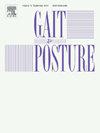SynergyFF:使用肌肉协同前馈控制作为CPG来模拟蹲姿的单一射击方法
IF 2.2
3区 医学
Q3 NEUROSCIENCES
引用次数: 0
摘要
中枢模式发生器(CPG)是一个负责产生运动模式的功能性网络。有人认为,运动CPG由一个基本的节律发生器和一个神经元间网络组成,本质上实现肌肉协同作用。不跟踪实验数据的预测模拟已被用于研究步态病理,并解释肌肉缺陷与异常步态之间的因果关系。然而,频繁的硬膝和蹲姿已经被证明是难以模拟的,当进行单次射击时,双侧跖屈肌无力的预测模拟。方法根据目标函数对控制器参数进行优化,训练具有9个自由度、14个hill型肌腱驱动器的肌肉骨骼模型行走。我们开发了一种使用肌肉协同前馈控制(称为SynergyFF方法)作为CPG的单次射击预测模拟方法,并探索了其优点。结果在研究与跖屈肌无力相关的步态时,我们的SynergyFF模型能够模拟蹲姿,而经典的基于反射的模型无法模拟蹲姿。我们的模型也能够模拟跟骨和硬膝步态。我们的模拟的成功主要是由更准确的膝关节屈曲力矩建模驱动的。结论基于协同假设的CPG能够模拟真实的异常步态。我们将这一结果归因于肌肉协同作用在我们产生蹲姿的框架中所起的关键作用。更一般地说,我们的模拟为CPG的存在和肌肉协同假说提供了支持。本文章由计算机程序翻译,如有差异,请以英文原文为准。
SynergyFF: A single shooting method for simulating crouch gait using muscle synergy feedforward control as a CPG
Background
The central pattern generator (CPG) is a functional network responsible for the creation of motor patterns. It has been suggested that a locomotor CPG consists of a basic rhythm generator and an interneuronal network, essentially implementing muscle synergy. Predictive simulations without tracking experimental data have been used to study gait pathologies, and to explain the causal-effect relationship between muscle deficiencies and abnormal gaits. However, frequent stiff-knee and crouch gaits have proven difficult to simulate when performing single shooting predictive simulations of bilateral plantarflexor weakness.
Methods
We trained a musculoskeletal model with 9 degrees of freedom and 14 Hill-type musculotendon actuators to walk by optimizing the parameters of the controller with respect to an objective function. We developed a single shooting predictive simulation method using muscle-synergy feedforward control (called the SynergyFF method) as the CPG and explored its advantages.
Results
When studying gaits associated with plantarflexor weakness, our SynergyFF model was able to simulate crouch gait that could not be simulated by the classical reflex-based model. Our model was also able to simulate calcaneal and stiff-knee gaits. The success of our simulations was primarily driven by more accurate modeling of the knee flexion moment.
Conclusions
The CPG based on synergy hypothesis was able to produce realistic simulations of abnormal gaits. We attribute this result to the critical role played by muscle synergy in our framework for the generation of crouch gait. More generally, our simulations provide support for the existence of CPG and the hypothesis of muscle synergy.
求助全文
通过发布文献求助,成功后即可免费获取论文全文。
去求助
来源期刊

Gait & posture
医学-神经科学
CiteScore
4.70
自引率
12.50%
发文量
616
审稿时长
6 months
期刊介绍:
Gait & Posture is a vehicle for the publication of up-to-date basic and clinical research on all aspects of locomotion and balance.
The topics covered include: Techniques for the measurement of gait and posture, and the standardization of results presentation; Studies of normal and pathological gait; Treatment of gait and postural abnormalities; Biomechanical and theoretical approaches to gait and posture; Mathematical models of joint and muscle mechanics; Neurological and musculoskeletal function in gait and posture; The evolution of upright posture and bipedal locomotion; Adaptations of carrying loads, walking on uneven surfaces, climbing stairs etc; spinal biomechanics only if they are directly related to gait and/or posture and are of general interest to our readers; The effect of aging and development on gait and posture; Psychological and cultural aspects of gait; Patient education.
 求助内容:
求助内容: 应助结果提醒方式:
应助结果提醒方式:


